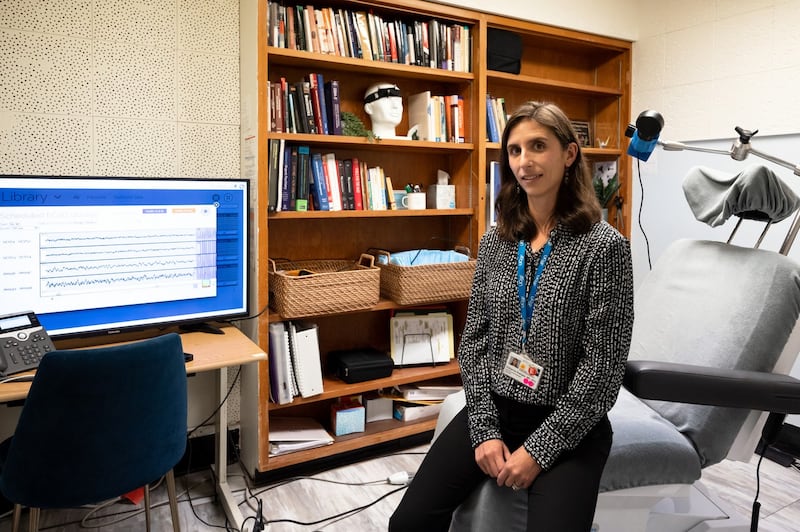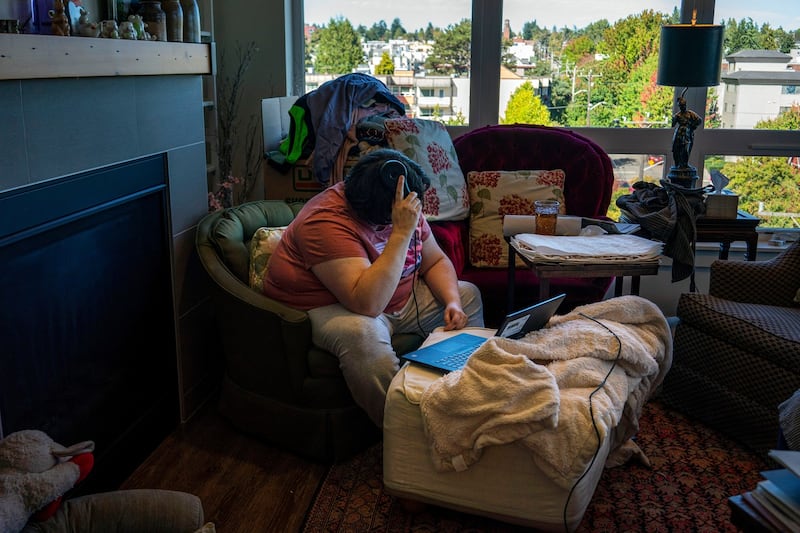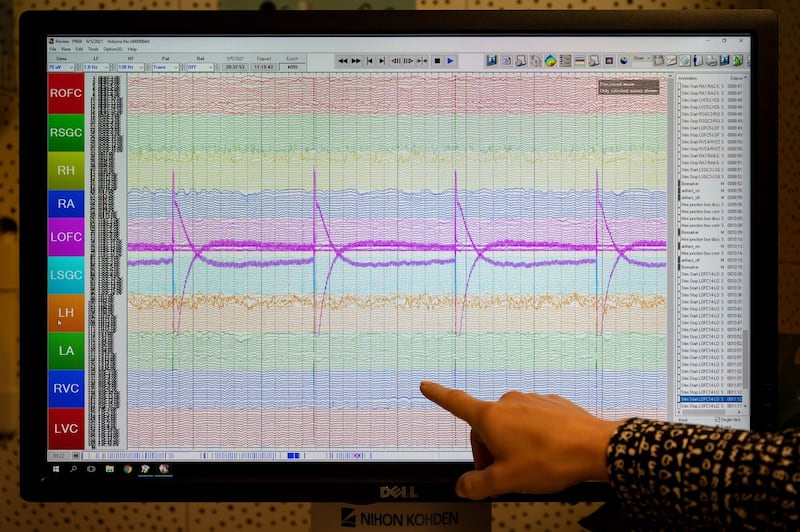Driving home from work in Northern California in the United States five years ago, a young woman was so overwhelmed with depression that all she could think about was ending her life. “I couldn’t stop crying,” recalled Sarah, now aged 38. “The thought that consumed me the entire way on that road was just driving my car into the marshland so I can drown.”
She made it home but moved in with her parents soon after because doctors considered it unsafe for her to live alone. No longer able to function at work, she quit her health technology job. She tried nearly every treatment: about 20 medications, months in a hospital day programme, electroconvulsive therapy, transcranial magnetic stimulation. But as with nearly a third of the more than 250 million people with depression worldwide, her symptoms persisted.
Then Sarah became the first participant in an unusual study of an experimental therapy. Now, her depression is so manageable that she’s taking data analysis classes, has moved to her own place and helps care for her mother, who suffered a fall.
The device has kept my depression at bay, allowing me to return to my best self and rebuild a life worth living
“Within a few weeks, the suicidal thoughts just disappeared,” said Sarah, who asked to be identified by only her first name to protect her privacy. “Then it was just a gradual process where it was like my lens on the world changed.” Researchers at the University of California, San Francisco (UCSF), surgically implanted a battery-operated, matchbox-size device in Sarah’s brain – a “pacemaker for the brain,” some call it – calibrated to detect the neural activity pattern that occurs when she is becoming depressed. It then delivers pulses of electrical stimulation to stave off depression.
Twelve days after Sarah’s device was fully operational in August 2020, her score on a standard depression scale dropped to 14 from 33, and several months later, it fell below 10, essentially signalling remission, the researchers reported. “The device has kept my depression at bay, allowing me to return to my best self and rebuild a life worth living,” Sarah said. Sarah’s is the first documented case of personalising a technique called deep brain stimulation to successfully treat depression. Much more research is needed before it’s clear how effective the approach could be and for how many patients. But several teams of scientists are now working on ways to essentially match the electrical stimulation to what happens in an individual patient’s brain.
Deep brain stimulation is used to treat Parkinson’s disease and several other disorders, but isn’t approved by regulators for depression because results have been inconsistent. While some previous studies suggested benefits, two trials sponsored by US device companies were stopped in the last decade because stimulation seemed no better than the placebo effect of a “sham” implant that provided no stimulation.
But those studies didn’t target individualised locations or patterns of electrical activity in people’s brains. It was “one size fits all,” said Dr Darin Dougherty, director of neurotherapeutics at Massachusetts General Hospital, who worked on one of the halted trials. He called the personalised approach with Sarah, which he wasn’t involved in, “very exciting”.
“One person’s depression might look very different from another person’s depression,” said Dr Katherine Scangos, an assistant professor of psychiatry at UCSF and an author of a report about Sarah’s case published on Monday in the journal Nature Medicine. The senior authors were Dr Andrew Krystal, an expert in neuro-modulation and mood disorders, and Dr Edward Chang, whose work includes brain implants for paralysed patients who cannot speak.

To identify the specific brain activity pattern linked to Sarah’s depression, researchers conducted an intensive 10-day exploration of Sarah’s brain, placing multiple electrodes in it and asking about her feelings when they applied stimulation to different locations in varying doses.
Sarah remembers an “aha moment” when she felt like “the Pillsbury Doughboy”, emitting a “giant belly laugh”, which she said was “the first time I spontaneously laughed and smiled” in five years. Another feeling resembled “being in front of a warm fire and reading a comforting book”, while a negative sensation felt like “nails on a chalkboard”.
Eventually, the team identified a specific pattern of electrical activity that coincided with Sarah becoming depressed. The exploratory phase guided the researchers to place the stimulation device in Sarah’s right brain hemisphere linked to electrodes in two regions. One was the ventral striatum, involved in emotion, motivation and reward, where stimulation “consistently eliminated her feelings of depression”, and the other the amygdala, where changes could “predict when her symptoms were most severe”, Scangos said.
While deep brain stimulation is typically delivered continuously, Sarah’s device is set to supply only a six-second burst when it recognises her depression-linked brain activity pattern. The goal, said Dougherty, is that stimulation will disrupt or shift the neural activity to produce a healthier pattern that will ease depressive symptoms. Sarah has continued taking psychiatric medications, and the stimulation hasn’t eliminated depression-causing activity in her brain. But she can manage her illness much better, she said, instead of being unable to make even the smallest decisions, like what to eat.
Now, “you’re experiencing that whole negative, depressive, whatever the triggering thing is, and then it’s like suddenly the ultra-rational side of you comes on and those emotions can be separated,” she said in an interview, wearing a T-shirt that said, “Take it easy lemon squeezy.”

That separation helps her productively use tools from talk therapy, such as staying calm and maintaining perspective. About 30 per cent of people with depression don’t respond to standard treatments or find the side effects intolerable. Deep brain stimulation wouldn’t be appropriate for all because it costs tens of thousands of dollars, and brain surgery to implant the device carries risks such as infection. But if the new attempts work, it might help a significant number, experts said. Chang said the research may also lead to non-invasive approaches that would help more people.
“Our job now is really to figure out what is it that identifies who needs this kind of intervention,” said Dr Helen Mayberg, director of the Center for Advanced Circuit Therapeutics at the Icahn School of Medicine in New York City, who pioneered the concept of deep brain stimulation for depression nearly 20 years ago.
Mayberg uses a different method of individualisation. With imaging, she finds the location in each person’s brain where four white matter bundles intersect near a key depression-related region. After implanting electrodes and a stimulation device, “we pretty much set it and forget it”, delivering stimulation continuously while also helping patients with conventional therapy.
Neural activity is monitored “to learn the brain signature that heralds an impending depressive relapse or need for a dose adjustment, or just indicates that the person is just having a bad week”, Mayberg said. She led one of the halted trials, but her work has also allowed patients to experience improvements that continue for years if stimulation is sustained.
In another approach, Dr Sameer Sheth, an associate professor of neurosurgery at Baylor College of Medicine, and colleagues study a patient’s specific brain activity pattern to identify which of billions of combinations of stimulation characteristics, such as frequency and amplitude, improve that patient’s depression. He then tunes electrodes in two regions and applies that specific combination as continuous stimulation.
Sheth said the first patient, given the device in March 2020, “is remarkably well” now, maintaining a relationship and becoming a father. To test for a placebo effect, researchers gradually stopped stimulation to one brain region without the patient knowing when. His depression “got worse and worse”, Sheth said, until he needed “rescue”. After stimulation restarted, he improved, suggesting that the effect “is definitely stimulation-related”.
Several months ago, Sarah needed a rescue too. Shortly after she entered a study phase where the device is either turned off or left on for six weeks without the participant knowing which, “the suicidal thoughts were back”, she said. Her family tried to get her hospitalised, but hospitals were full.
“Things were really bad,” Sarah said. “She did have a very severe worsening of her depression,” Scangos said. She said she couldn’t disclose whether stimulation had been off or on, but said a device company technician was sent to Sarah’s home to “make a rescue change”. Afterwards, Sarah said, she improved again.

Over the year, the number of times a day that Sarah’s device has detected depression-linked brain activity and delivered stimulation has decreased somewhat but is still substantial, Scangos said. Still, some days Sarah doesn’t need the maximum amount the device is set to provide: 300 times or 30 total minutes daily. (It automatically stops around 6pm because evening stimulation made her too alert to sleep.) Longer-term and more detailed data on Sarah will be published later, said the researchers, who have two other participants so far.
The device is intentionally tuned so Sarah cannot feel the stimulation, but she believes she knows that it’s occurred because she subsequently develops a sense of “emotional distance” that keeps negative feelings “compartmentalised”, she said. Also, “I feel alert,” she said. “I feel present.” That’s “a really good sign”, said Dougherty, who is considering using a similar approach for depression and possibly addiction. “The emotions are still there, but instead of sticking like mud, it’s running off like water.”
To help researchers correlate brain activity with emotional states, two or three times a day, Sarah holds a doughnut-shaped magnet to her head, triggering the device to save the next 90 seconds of neural activity, and she completes a mental health survey. She’s been encouraged to pick moments “when she’s in a very good mood or a bad mood”, Scangos said. Also, twice daily, 12 minutes of neural data are automatically relayed to the device company and researchers.
Hobbies I used to distract myself from suicidal thoughts suddenly became pleasurable again
One question, experts said, is whether Sarah’s results support the theory that stimulating briefly whenever depression begins works because it keeps the brain from becoming accustomed to the treatment. Or, Sheth asked, does Sarah’s need for many daily doses after a year suggest continuous stimulation would be as or more effective? Another question is whether the therapy can prompt lasting brain changes to eventually avert depression with little or no continuing stimulation.
Researchers, several of whom consult for device companies or have patents related to deep brain stimulation, expect it will take years to learn if individualised approaches are effective enough to be approved. Different methods might work for different people’s depression, and individualised stimulation might eventually help other psychiatric disorders, researchers say.
The most elemental things have improved for Sarah, who said she’s started to “relearn my life” and that “hobbies I used to distract myself from suicidal thoughts suddenly became pleasurable again”. When depressed, Sarah, a passionate cook and foodie, had such slow reflexes and trouble functioning that she’d cut or burn herself in the kitchen, and doctors told her it wasn’t safe to cook anymore. Foods had little flavour. But after receiving the device, she ate Vietnamese pho in the hospital cafeteria and was thrilled she could taste “the brightness and the herbs”, she said.
While being driven home from the hospital, she saw the marshes and exclaimed: “God, the colour differentiation is gorgeous.” Now, she said, she’s “seeing things that are beautiful in the world, and when I was in the depths of depression, all I saw was what was ugly.”
If you are having thoughts of suicide, contact the Samaritans on 116 123 or through their online chat, or go to HSE.ie for a list of additional services. – This article originally appeared in the New York Times

















